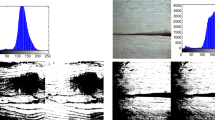Abstract
To measure the bracelet automatically, a novel method based on feature energy is proposed. Firstly, the morphological method is utilized to preprocess the image, and the contour consisting of a concentric circle is extracted. Then, a feature energy function, which is relevant to the distances from one pixel to the edge points, is defined taking into account the geometric properties of the concentric circle. The input image is subsequently transformed to the feature energy distribution map (FEDM) by computing the feature energy of each pixel. The center of the concentric circle is thus located by detecting the maximum on the FEDM; meanwhile, the radii of the concentric circle are determined according to the feature energy function of the center pixel. Finally, with the use of a calibration template, the internal diameter and thickness of the bracelet are measured. The experimental results show that the proposed method can measure the true sizes of the bracelet accurately with the simplicity, directness and robustness compared to the existing methods.








Similar content being viewed by others
References
Mukhopadhyay, P., & Chaudhuri, B. B. (2014). A survey of hough transform. Pattern Recognition, 48(3), 993–1010.
Cao, X., & Deravi, F. (1992). An efficient method for the detection of multiple concentric circles. IEEE International Conference on Acoustics, 3, 137–140.
Silveira, M. (2005). An algorithm for the detection of multiple concentric circles. Lecture Notes in Computer Science, 3523, 143–224.
Qiao, N. S., Ye, Y. T., Mo, C. H., et al. (2010). Method for the detection of concentric circles of photoelectric image of circular hole in printed circuit board. Acta Optica Sinica, 30(1), 75–78.
Yue, G. H., Lu, C. H., Sheng, L. Q., & Liu, Y. N. (2012). A combined method for concentric circles detection in image of o-shape rubber ring. Advanced Materials Research, 488–489, 1619–1623.
Ying, X., & Zha, H. (2007). An efficient method for the detection of projected concentric circles. IEEE International Conference on Image Processing, 6, VI-560–VI-563.
Chen, X., Lu, L., & Gao, Y. (2012). A new concentric circle detection method based on Hough transform. In International conference on computer science and education (pp. 753–758).
Chen, X., Lu, L., & Yang, S. (2014). Concentric circle detection based on normalized distance variance and the straight line Hough transform. IEEE International Conference on Computer Science & Education, 96, e84–e84.
Akinlar, C., & Topal, C. (2013). Edcircles: A real-time circle detector with a false detection control. Pattern Recognition, 46(3), 725–740.
Marco, T. D., Cazzato, D., Leo, M., & Distante, C. (2015). Randomized circle detection with isophotes curvature analysis. Pattern Recognition, 48(2), 411–421.
Yuan, B., & Liu, M. (2015). Power histogram for circle detection on images. Pattern Recognition, 48(10), 3268–3280.
Liu, H. M., & Wang, Z. H. (2013). PLDD: Point-lines distance distribution for detection of arbitrary triangles, regular polygons and circles. Journal of Visual Communication and Image Representation, 25(2), 273–284.
Scitovski, R., & Marošević, T. (2015). Multiple circle detection based on center-based clustering. Pattern Recognition Letters, 52, 9–16.
Liu, D., Wang, Y., Tang, Z., & Lu, X. (2015). A robust circle detection algorithm based on top-down least-square fitting analysis. Optics Communications, 343(4), 66–72.
Cai, J., Huang, P., Chen, L., & Zhang, B. (2016). An efficient circle detector not relying on edge detection. Advances in Space Research, 57(11), 2359–2375.
Acknowledgements
This work is supported by the National Natural Science Foundation of China (61572173, 61472119 and 61472373), the program for Science and Technology Innovation Talents in Universities of Henan Province (13HASTIT039), Henan Polytechnic University Innovative Research Team (T2014-3) and Henan Polytechnic University Fund for Distinguished Young Scholars (J2016-3).
Author information
Authors and Affiliations
Corresponding author
Rights and permissions
About this article
Cite this article
Liu, H., Li, L., Wang, Z. et al. A Method to Measure the Bracelet Based on Feature Energy. Sens Imaging 18, 14 (2017). https://doi.org/10.1007/s11220-017-0163-x
Received:
Revised:
Published:
DOI: https://doi.org/10.1007/s11220-017-0163-x




